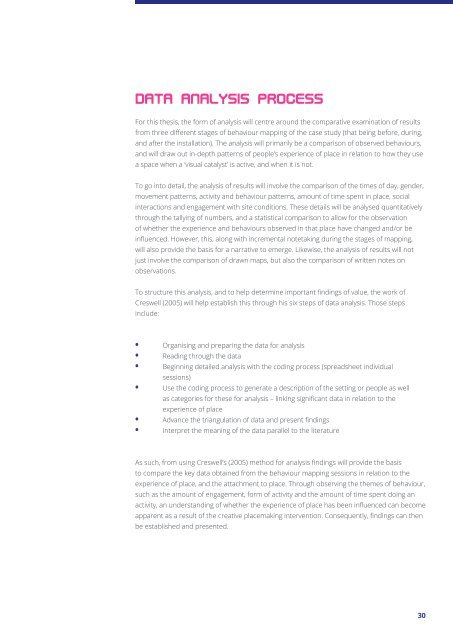Exploring the Role of 'Visual Catalysts' on Influencing People's Attraction and Use of Place
Undergraduate Thesis // Keegan Lovell // Bachelor of Landscape Architecure // UNSW 2016
Undergraduate Thesis // Keegan Lovell // Bachelor of Landscape Architecure // UNSW 2016
You also want an ePaper? Increase the reach of your titles
YUMPU automatically turns print PDFs into web optimized ePapers that Google loves.
DATA ANALYSIS PROCESS<br />
For this <str<strong>on</strong>g>the</str<strong>on</strong>g>sis, <str<strong>on</strong>g>the</str<strong>on</strong>g> form <str<strong>on</strong>g>of</str<strong>on</strong>g> analysis will centre around <str<strong>on</strong>g>the</str<strong>on</strong>g> comparative examinati<strong>on</strong> <str<strong>on</strong>g>of</str<strong>on</strong>g> results<br />
from three different stages <str<strong>on</strong>g>of</str<strong>on</strong>g> behaviour mapping <str<strong>on</strong>g>of</str<strong>on</strong>g> <str<strong>on</strong>g>the</str<strong>on</strong>g> case study (that being before, during,<br />
<strong>and</strong> after <str<strong>on</strong>g>the</str<strong>on</strong>g> installati<strong>on</strong>). The analysis will primarily be a comparis<strong>on</strong> <str<strong>on</strong>g>of</str<strong>on</strong>g> observed behaviours,<br />
<strong>and</strong> will draw out in-depth patterns <str<strong>on</strong>g>of</str<strong>on</strong>g> people’s experience <str<strong>on</strong>g>of</str<strong>on</strong>g> place in relati<strong>on</strong> to how <str<strong>on</strong>g>the</str<strong>on</strong>g>y use<br />
a space when a ‘visual catalyst’ is active, <strong>and</strong> when it is not.<br />
To go into detail, <str<strong>on</strong>g>the</str<strong>on</strong>g> analysis <str<strong>on</strong>g>of</str<strong>on</strong>g> results will involve <str<strong>on</strong>g>the</str<strong>on</strong>g> comparis<strong>on</strong> <str<strong>on</strong>g>of</str<strong>on</strong>g> <str<strong>on</strong>g>the</str<strong>on</strong>g> times <str<strong>on</strong>g>of</str<strong>on</strong>g> day, gender,<br />
movement patterns, activity <strong>and</strong> behaviour patterns, amount <str<strong>on</strong>g>of</str<strong>on</strong>g> time spent in place, social<br />
interacti<strong>on</strong>s <strong>and</strong> engagement with site c<strong>on</strong>diti<strong>on</strong>s. These details will be analysed quantitatively<br />
through <str<strong>on</strong>g>the</str<strong>on</strong>g> tallying <str<strong>on</strong>g>of</str<strong>on</strong>g> numbers, <strong>and</strong> a statistical comparis<strong>on</strong> to allow for <str<strong>on</strong>g>the</str<strong>on</strong>g> observati<strong>on</strong><br />
<str<strong>on</strong>g>of</str<strong>on</strong>g> whe<str<strong>on</strong>g>the</str<strong>on</strong>g>r <str<strong>on</strong>g>the</str<strong>on</strong>g> experience <strong>and</strong> behaviours observed in that place have changed <strong>and</strong>/or be<br />
influenced. However, this, al<strong>on</strong>g with incremental notetaking during <str<strong>on</strong>g>the</str<strong>on</strong>g> stages <str<strong>on</strong>g>of</str<strong>on</strong>g> mapping,<br />
will also provide <str<strong>on</strong>g>the</str<strong>on</strong>g> basis for a narrative to emerge. Likewise, <str<strong>on</strong>g>the</str<strong>on</strong>g> analysis <str<strong>on</strong>g>of</str<strong>on</strong>g> results will not<br />
just involve <str<strong>on</strong>g>the</str<strong>on</strong>g> comparis<strong>on</strong> <str<strong>on</strong>g>of</str<strong>on</strong>g> drawn maps, but also <str<strong>on</strong>g>the</str<strong>on</strong>g> comparis<strong>on</strong> <str<strong>on</strong>g>of</str<strong>on</strong>g> written notes <strong>on</strong><br />
observati<strong>on</strong>s.<br />
To structure this analysis, <strong>and</strong> to help determine important findings <str<strong>on</strong>g>of</str<strong>on</strong>g> value, <str<strong>on</strong>g>the</str<strong>on</strong>g> work <str<strong>on</strong>g>of</str<strong>on</strong>g><br />
Creswell (2005) will help establish this through his six steps <str<strong>on</strong>g>of</str<strong>on</strong>g> data analysis. Those steps<br />
include:<br />
• Organising <strong>and</strong> preparing <str<strong>on</strong>g>the</str<strong>on</strong>g> data for analysis<br />
• Reading through <str<strong>on</strong>g>the</str<strong>on</strong>g> data<br />
• Beginning detailed analysis with <str<strong>on</strong>g>the</str<strong>on</strong>g> coding process (spreadsheet individual<br />
sessi<strong>on</strong>s)<br />
• <strong>Use</strong> <str<strong>on</strong>g>the</str<strong>on</strong>g> coding process to generate a descripti<strong>on</strong> <str<strong>on</strong>g>of</str<strong>on</strong>g> <str<strong>on</strong>g>the</str<strong>on</strong>g> setting or people as well<br />
as categories for <str<strong>on</strong>g>the</str<strong>on</strong>g>se for analysis – linking significant data in relati<strong>on</strong> to <str<strong>on</strong>g>the</str<strong>on</strong>g><br />
experience <str<strong>on</strong>g>of</str<strong>on</strong>g> place<br />
• Advance <str<strong>on</strong>g>the</str<strong>on</strong>g> triangulati<strong>on</strong> <str<strong>on</strong>g>of</str<strong>on</strong>g> data <strong>and</strong> present findings<br />
• Interpret <str<strong>on</strong>g>the</str<strong>on</strong>g> meaning <str<strong>on</strong>g>of</str<strong>on</strong>g> <str<strong>on</strong>g>the</str<strong>on</strong>g> data parallel to <str<strong>on</strong>g>the</str<strong>on</strong>g> literature<br />
As such, from using Creswell’s (2005) method for analysis findings will provide <str<strong>on</strong>g>the</str<strong>on</strong>g> basis<br />
to compare <str<strong>on</strong>g>the</str<strong>on</strong>g> key data obtained from <str<strong>on</strong>g>the</str<strong>on</strong>g> behaviour mapping sessi<strong>on</strong>s in relati<strong>on</strong> to <str<strong>on</strong>g>the</str<strong>on</strong>g><br />
experience <str<strong>on</strong>g>of</str<strong>on</strong>g> place, <strong>and</strong> <str<strong>on</strong>g>the</str<strong>on</strong>g> attachment to place. Through observing <str<strong>on</strong>g>the</str<strong>on</strong>g> <str<strong>on</strong>g>the</str<strong>on</strong>g>mes <str<strong>on</strong>g>of</str<strong>on</strong>g> behaviour,<br />
such as <str<strong>on</strong>g>the</str<strong>on</strong>g> amount <str<strong>on</strong>g>of</str<strong>on</strong>g> engagement, form <str<strong>on</strong>g>of</str<strong>on</strong>g> activity <strong>and</strong> <str<strong>on</strong>g>the</str<strong>on</strong>g> amount <str<strong>on</strong>g>of</str<strong>on</strong>g> time spent doing an<br />
activity, an underst<strong>and</strong>ing <str<strong>on</strong>g>of</str<strong>on</strong>g> whe<str<strong>on</strong>g>the</str<strong>on</strong>g>r <str<strong>on</strong>g>the</str<strong>on</strong>g> experience <str<strong>on</strong>g>of</str<strong>on</strong>g> place has been influenced can become<br />
apparent as a result <str<strong>on</strong>g>of</str<strong>on</strong>g> <str<strong>on</strong>g>the</str<strong>on</strong>g> creative placemaking interventi<strong>on</strong>. C<strong>on</strong>sequently, findings can <str<strong>on</strong>g>the</str<strong>on</strong>g>n<br />
be established <strong>and</strong> presented.<br />
30


